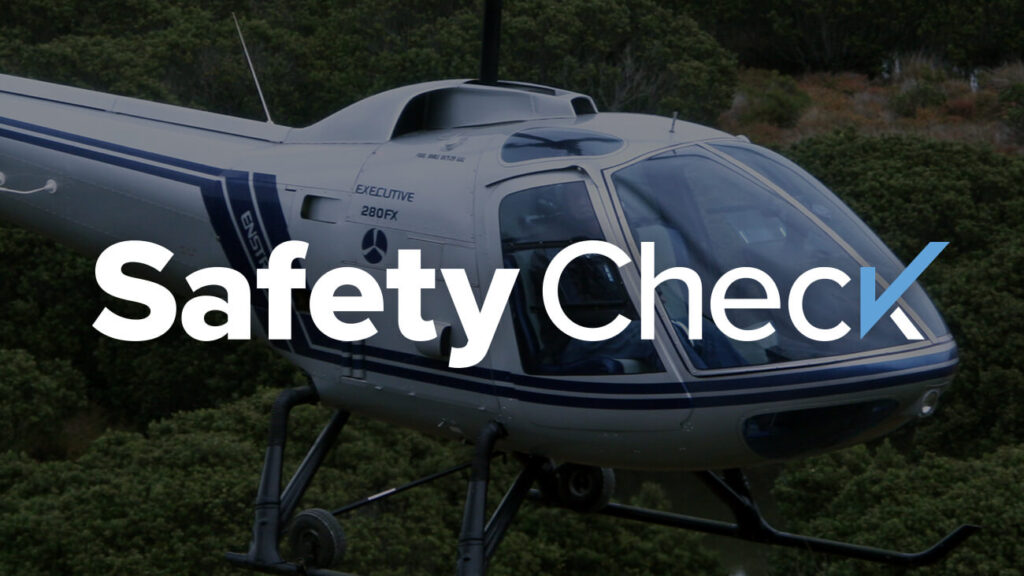Safety Check – July

The More We Look, the Less We See
This month’s Safety Check we are talking about preflight inspections and how complacency can become a flight risk. When I searched “inadequate preflight inspections” I was shocked with how many reports came up on helicopters alone. So, I decided to focus on Enstrom’s specifically. Fortunately, that reduced the number substantially, but none the less, I still found a few.
One of the reports involved an F-28C that was substantially damaged during a forced landing to a field following a tail rotor control failure. The commercially rated pilot and the passenger were not injured. The pilot reported he felt an abrupt “high vibration” in the tail rotor system in conjunction with a sharp jerk in the anti-torque pedals. The pilot performed an autorotation to an open field where the left skid collapsed and the helicopter rolled on its side.
The FAA inspector assigned to the case had extensive operational experience in Enstrom helicopters, performed an examination of the helicopter and found that the pitch change link retaining bolt for the tail rotor pitch system had come loose in the pitch change link attachment horn. Further examination showed the pitch link attachment horn had “excessive wear” and was elongated. The tail rotor control cables were also severed. According to the inspector, the tail rotor pitch links are critical components of the helicopter and they are required to be visually inspected per the FAA approved Enstrom F-28C preflight inspection checklist for binding and looseness. The FAA inspector determined in his NTSB Final report that the pilot “should have caught the loose bolt” during his preflight inspection.
I am in no way faulting the pilot for this accident. This is just one of many NTSB accident reports that are available from the FAA’s website. As a Designated Pilot Examiner, I prefer to use these reports as a learning tool for new pilots. In fact, I use three to four reports during the oral portion of the practical exam to test applicants. I will give them the actual report and white out the probable cause and ask the applicant to be the inspector to determine the cause and what could have been done to prevent it. In this case, the answer might have been a more thorough preflight inspection.
Roger Sharkey, of Sharkey’s Helicopters (great friend, no relation) once told me of a Bell 407 he had in his shop for a routine inspection. The Director of Maintenance called Roger to the shop floor where he showed him a large socket wrench in the bay of the engine compartment. Luckily it had not fallen down where it could have interfered with the aircraft’s control system. It had been determined that socket had probably been in there since the last inspection at a different maintenance facility some 25 hours ago! That means whoever had flown that aircraft in the past 25 hours had not opened up the engine compartment doors as instructed by the approved Bell checklist.
So why are items being missed on preflight checklists?
- It is distractions, maybe responding to a call or text?
- Is it that we are rushed, passengers showed up early?
- Is it complacency, “I was the last guy to have flown this aircraft and it was perfect then so why waste my time looking again?”
It seems like when we are familiar with a certain aircraft, we spend less time looking for discrepancies. Do me a favor – the next time you preflight the aircraft that you are the PIC – treat it like your first practical test where the examiner is looking over your shoulder. Yes, it likely will take more time. Roger Sharkey mandates all of his students and customers fill out a printable checklist and sign and date it before EVERY flight. It’s not a bad idea. In fact, if you would like a copy, he would be thrilled to email you a master copy. He has printable preflight checklists for all of the Enstrom models. Just email roger@sharkeys.com.
Until me meet again next month – Here’s to safe and happy flying!

Randy is a dual rated Airline Transport Pilot with 13,000 flight hours in airplanes and helicopters. He has type ratings in the BE400 and CE500. Randy has been a rotorcraft Designated Pilot Examiner representing the Grand Rapids FSDO since 2014. Currently he works for Sweet Helicopters, a northern Indiana Part 135 air carrier operator and serves as the Airport Manager of the Goshen Municipal Airport.
About Enstrom Helicopter
From Rudy Enstrom’s early designs in 1943 to initial testing in a Michigan Quarry in 1957 to aircraft operating on six continents, Enstrom Helicopter Corporation has maintained a reputation for safety, value and performance. Based in Menominee, Michigan and proudly made in the United States, Enstrom has a rich history for design innovation. The goal is to provide helicopters to the customer’s exact specification and deliver support and maintenance worldwide.